NVIDIA's GeForce GTX 560 Ti: Upsetting The $250 Market
by Ryan Smith on January 25, 2011 9:00 AM ESTCompute & Tessellation
Moving on from our look at gaming performance, we have our customary look at compute performance, bundled with a look at theoretical tessellation performance. Unlike our gaming benchmarks where NVIDIA’s architectural differences between GF114 and GF110 are largely irrelevant, they can become much more important under a compute-bound situation depending on just how much ILP can be extracted for the GTX 560 Ti.
Our first compute benchmark comes from Civilization V, which uses DirectCompute to decompress textures on the fly. Civ V includes a sub-benchmark that exclusively tests the speed of their texture decompression algorithm by repeatedly decompressing the textures required for one of the game’s leader scenes.
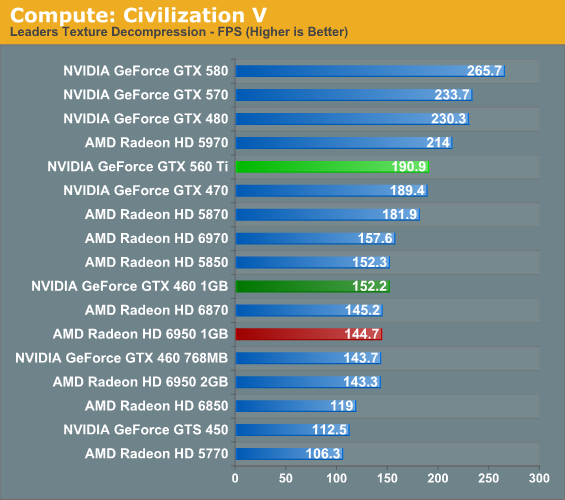
Under our Civilization 5 compute benchmark we have a couple of different things going on even when we just look at the NVIDIA cards. Compared to the GTX 460 1GB, the GTX 560 enjoys a 31% performance advantage; this is less than the theoretical maximum of 39%, but not far off from the performance advantages we’ve seen in most games. Meanwhile the GTX 470 is practically tied with the GTX 560 even though on paper the GTX 560 has around a 15% theoretical performance advantage. This ends up being a solid case of where the limitations of ILP come in to play, as clearly the GTX 560 isn’t maximizing the use of its superscalar shaders. Or to put it another way, it’s an example as to why NVIDIA isn’t using a superscalar design on their Tesla products.
Meanwhile this benchmark has always favored NVIDIA’s architectures, so in comparison to AMD’s cards there’s little to be surprised about. The GTX 560 Ti is well in the lead, with the only AMD card it can’t pass being the dual-GPU 5970.
Our second GPU compute benchmark is SmallLuxGPU, the GPU ray tracing branch of the open source LuxRender renderer. While it’s still in beta, SmallLuxGPU recently hit a milestone by implementing a complete ray tracing engine in OpenCL, allowing them to fully offload the process to the GPU. It’s this ray tracing engine we’re testing.
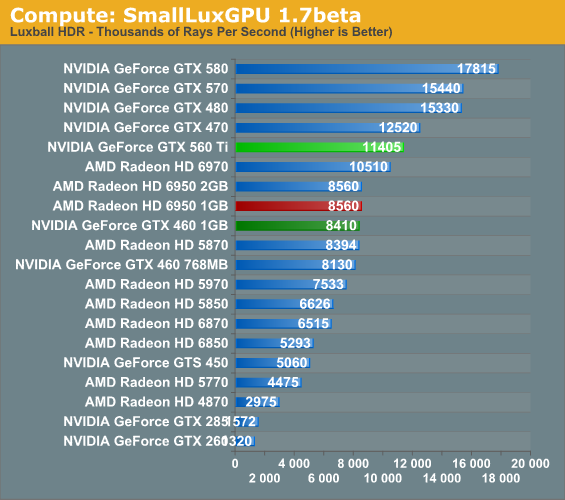
Small Lux GPU is the other test in our suite where NVIDIA’s drivers significantly revised our numbers. Where this test previously favored raw theoretical performance, giving the vector-based Radeons an advantage, NVIDIA has now shot well ahead. Given the rough state of both AMD and NVIDIA’s OpenCL drivers, we’re attributing this to bug fixes or possibly enhancements in NVIDIA’s OpenCL driver, with the former seeming particularly likely. However NVIDIA is not alone when it comes to driver fixes, and AMD has seem a similar uptick against the newly released 6900 series. It’s not nearly the leap NVIDIA saw, but it’s good for around 25%-30% more rays/second under SLG. This appears to be accountable to further refinement of AMD’s VLIW4 shader compiler, which as we have previously mentioned stands to gain a good deal of performance as AMD works on optimizing it.
So where does SLG stack up after the latest driver enhancements? With NVIDIA’s rocket to the top, they’re now easily dominating this benchmark. The GTX 560 Ti is now slightly ahead of the 6970, never mind the 6950 1GB where it has a 33% lead. Rather than being a benchmark that showed the advantage of having lots of theoretical compute performance, this is now a benchmark that seems to favor NVIDIA’s compute-inspired architecture.
Our final compute benchmark is a Folding @ Home benchmark. Given NVIDIA’s focus on compute for Fermi, cards such as the GTX 560 Ti can be particularly interesting for distributed computing enthusiasts, who are usually looking for a compute card first and a gaming card second.
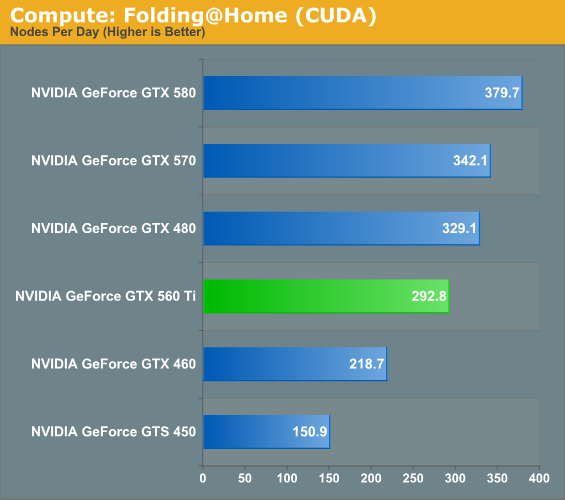
Against the senior members of the GTX 500 series and even the GTX 480 the GTX 560 Ti is still well behind, but at the same time Folding @ Home does not look like it significantly penalizes GTX 560’s superscalar architecture.
At the other end of the spectrum from GPU computing performance is GPU tessellation performance, used exclusively for graphical purposes. With Fermi NVIDIA bet heavily on tessellation, and as a result they do very well at very high tessellation factors. With 2 GPCs the GTX 560 Ti can retire 2 triangles/clock, the same rate as the Radeon HD 6900 series, so this should be a good opportunity to look at theoretical architectural performance versus actual performance.
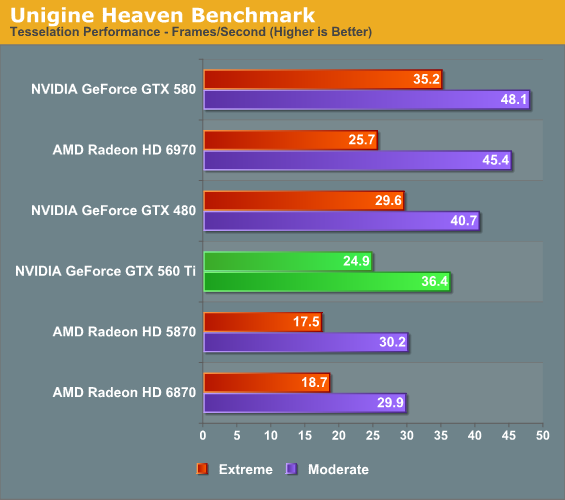
Against the AMD 5800 and 6800 series, the GTX 560 enjoys a solid advantage, as it’s able to retire twice as many triangles per clock as either architecture. And while it falls to both GTX 480 and GTX 580, the otherwise faster Radeon HD 6970 is close at times – at moderate tessellation it has quite the lead, but the two are neck-and-neck at extreme tessellation where triangle throughput and the ability to efficiently handle high tessellation factors counts for everything. Though since Heaven is a synthetic benchmark at the moment (the DX11 engine isn’t currently used in any games) we’re less concerned with performance relative to AMD’s cards and more concerned with performance relative to the other NVIDIA cards.
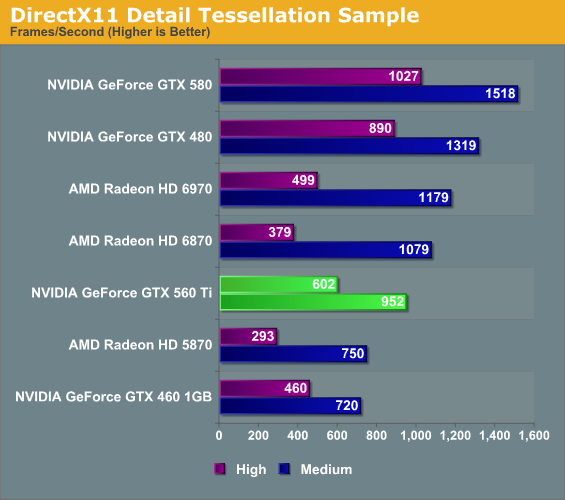
Microsoft’s Detail Tessellation sample program showcases NVIDIA’s bet on tessellation performance even more clearly. NVIDIA needs very high tessellation factors to shine compared to AMD’s cards. Meanwhile against the GTX 460 1GB our gains are a bit more muted; even though this is almost strictly a theoretical test, the GTX 560 only gains 30% on the GTX 460. Ultimately while the additional SM unlocks another tessellator on NVIDIA’s hardware, it does not unlock a higher triangle throughput rate, which is dictated by the GPCs.










87 Comments
View All Comments
ggathagan - Tuesday, January 25, 2011 - link
I believe you mean "Apparently Anandtech's efforts to find good writers were in vain."phoible4 - Tuesday, January 25, 2011 - link
The GTX560 looks interesting. However, prices for 768MB 460s are hitting rock bottom. I just paid $90 for one from TigerDirect (after rebates), and it looks like there are a few under $130 on Newegg. It seems like it would cost about the same to run SLI 460s and 1 560 (assuming your case can handle it), and I can guess that the SLI config would be faster in most games.I actually kind of expected NVidia to release a dual-chip 460 as their next-gen 580, and take a page out of AMD's playbook (wonder how hot/loud that would be).
Belard - Thursday, January 27, 2011 - link
The GF 460-768mb are slow compared to their 1Gb versions. They run out of memory way too quick. But for $90... that would be a great deal that is worthwhile. Newegg is showing $150 on avg for the 768mb 460s. Which is about $25 less than a newer 6850 card which is easily faster. Its even faster than the 1GB 460 and cost less.mosox - Tuesday, January 25, 2011 - link
[quoteAMD’s scramble to launch the Radeon HD 6950 1GB has produced a card with similar levels of performance and pricing as the GTX 560 Ti, making it impossible to just blindly recommend the GTX 560 Ti.[/quote]What? The 6950 2GB is faster than the 560 and the The 6950 2GB is FASTER than the 6950 2GB at every resolution except the highest ones like 2560x1600.
This is from Tom's:
mosox - Tuesday, January 25, 2011 - link
Read that as The 6950 1GB is FASTER than the 6950 2GB, sorry.Visual - Wednesday, January 26, 2011 - link
you read that right - "tighter memory timings"ritalinkid18 - Tuesday, January 25, 2011 - link
I would just like to say, very nice article... well written and informative. I've been a fan of anandtech for many years and the GPU articles never disappoint.Is it just me or does anyone else find reading about Nvidia's architecture a lot more interesting?
Also, I really hate that the comments are filled with people that say you are bias towards NVIDIA. To all those people, PLEASE go read the some other reviews. A majority of them praise the 560. This article is more critical of the 560 value than most.
jonks - Tuesday, January 25, 2011 - link
"The GTX 560 is always faster than the GTX 470, but never immensely so; and at higher resolutions the GTX 470 still has an advantage."So the 560 is always faster than the 470 except when it's not. :)
poohbear - Tuesday, January 25, 2011 - link
wow the gpu market is definitely intense! nvidia and AMD are neck & neck now, very nice time to buy a vid card!7Enigma - Tuesday, January 25, 2011 - link
Thanks again Ryan and Anandtech for keeping the 4870 in your charts for 1920X1200 res. I've always read the new gpu reviews and been saddened that although the new cards are fast they were still not approaching 2X the performance of my 4870. With the constant name change with the same parts, or slightly faster parts, it's taken until just about now to have a card worth the upgrade.Now my question is will I see the performance improvement in GAMES using my C2D 8500 (OC'd to 3.8GHz), or do I need to rebuild the system with Sandy Bridge to actually see the 2X GPU performance?